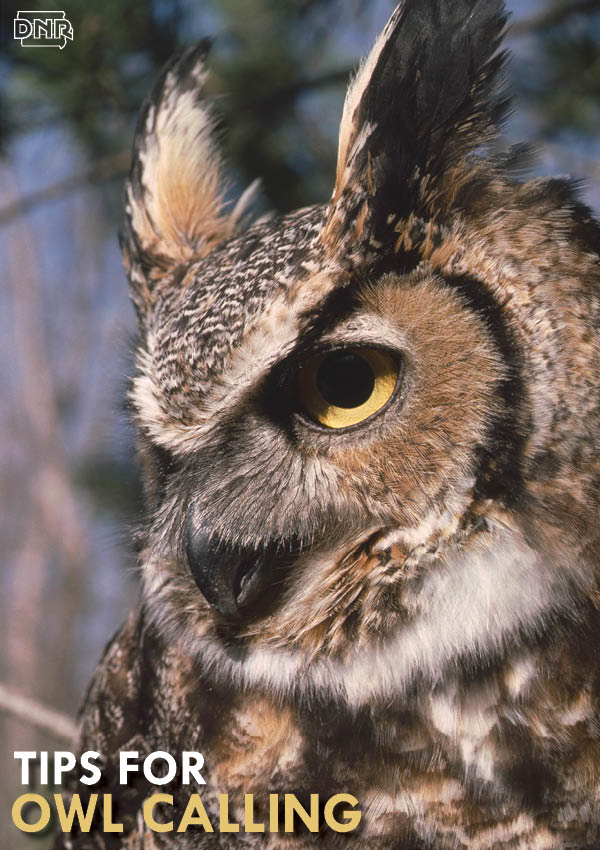 February’s full moon is nicknamed the owl moon, as the crisp night air is filled with the calls and hoots of mating owls. Crunch the snow and trek into the woods with a child—or the young at heart—to practice calling owls.
February’s full moon is nicknamed the owl moon, as the crisp night air is filled with the calls and hoots of mating owls. Crunch the snow and trek into the woods with a child—or the young at heart—to practice calling owls.
Use the moonlight reflecting off the snow-covered ground to illuminate the surroundings as you follow the sound of an owl’s call. Move slowly and patiently to glimpse owls silhouetted on leafless trees by shimmering moonbeams. When an owl calls, try to mimic the sound and see if you get a response.
All eight species of Iowa owls are found here in the winter. The great horned, screech and barred owls are most common. The short-eared is on the state endangered species list and the barn and long-eared are on the threatened list. If you glimpse one of these, you are lucky indeed.
Barred
Very common, most often heard in summer, spring and fall. Search along forested areas in river bottoms across the state, except northwest Iowa.
Screech
Common. Small, but slightly larger than a saw-whet owl. Found year-round in Iowa. Nocturnal, but will respond to calls day or night. Nests early spring and summer.
Burrowing
The only owl that nests underground, often using old badger or fox dens. Most recorded sightings are in northwest Iowa.
Short-eared
Endangered. A prairie species, find them hunting over open grasslands. A summer nester and one of the last to nest. “We have a small breeding number during the summer, but more short-ears are in Iowa during the winter, when they move south from prairie areas in Canada,” says Doug Harr, who heads the DNR’s nongame program.
Great Horned
The largest and easiest owl to find, they hoot in a series of five or six in late December and January to attract mates. By following the sound, you can see them sitting in an old red-tailed hawk nest, incubating eggs, even during a snowstorm. Often lay eggs by early February. Their owlets take a long time to mature, so they are the earliest nesters, doing so to take advantage of an early food supply for their young. Owlets can hunt on their own by summer, perfect timing to catch early populations of rabbits and rodents.
Long-eared
Threatened. Find in conifer groves in winter and sometimes in groups. The only owls that form flocks. Usually found in the same location year after year.
Snowy
Not here during summer, when the all-white snowy resides in the Arctic. “They come down when the food base of lemmings and mice has a population crash,” says Harr. That happens about every four years. “Not responsive to calls, you will just happen upon them sitting on a fencepost or on a frozen clod of dirt in an open field. A ground nester, they like to get on a perch to scan for prey.” Most are found north of Interstate 80.
Northern Saw-Whet
Our smallest owl, “Probably a lot more common than we realize, this owl is very secretive,” says Harr. Often found in winter in red cedar trees. They perch close to tree trunks and sometimes close to the ground. Unafraid of people, they can be approached within a few feet. “This is a species that we are just starting to understand more about,” says Harr.
Barn Owl
Rare, with less than ten known nests in the state. “There are probably more than that, but they are hard to find,” says Harr. An oak savannah species, they thrived when fire and natural free-roaming grazers such as elk kept the forest floor open, with knee-high grasses. A rare and quickly disappearing habitat, the oak forests are now often choked with above-head tangles of brush and woody plants. Barn owls have a distinctive heart-shaped facial shape. Often found in abandoned barns,
they are a year-round resident and a spring and summer nester.
Children and adults will enjoy listening to various owl calls online. Visit the famed Cornell Lab of Ornithology at www.birds.cornell.edu and search for owls.
This article originally appeared in the January/February 2010 issue of Iowa Outdoors magazine.